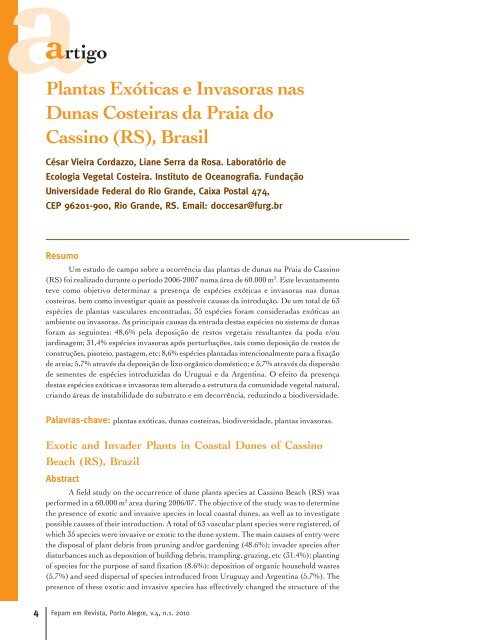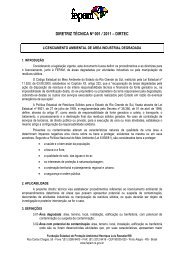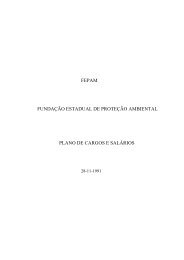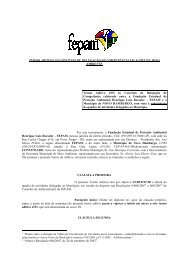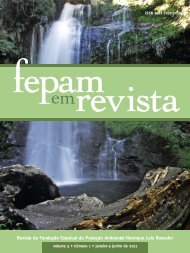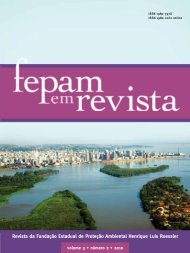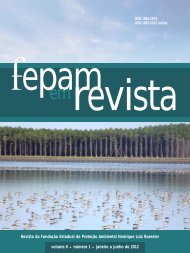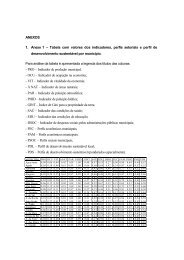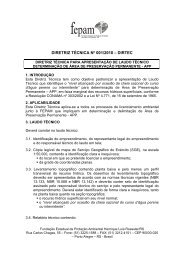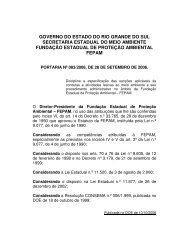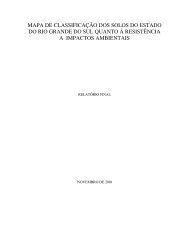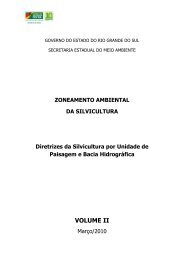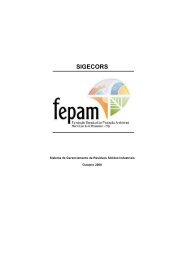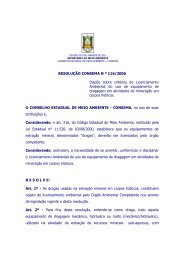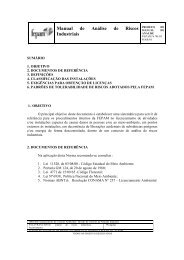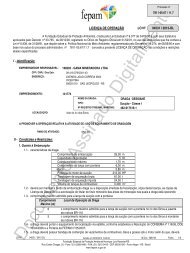Revista da Fundação Estadual de Proteção Ambiental ... - Fepam
Revista da Fundação Estadual de Proteção Ambiental ... - Fepam
Revista da Fundação Estadual de Proteção Ambiental ... - Fepam
Create successful ePaper yourself
Turn your PDF publications into a flip-book with our unique Google optimized e-Paper software.
artigo<br />
Plantas Exóticas e Invasoras nas<br />
Dunas Costeiras <strong>da</strong> Praia do<br />
Cassino (RS), Brasil<br />
César Vieira Cor<strong>da</strong>zzo, Liane Serra <strong>da</strong> Rosa. Laboratório <strong>de</strong><br />
Ecologia Vegetal Costeira. Instituto <strong>de</strong> Oceanografia. Fun<strong>da</strong>ção<br />
Universi<strong>da</strong><strong>de</strong> Fe<strong>de</strong>ral do Rio Gran<strong>de</strong>, Caixa Postal 474,<br />
CEP 96201-900, Rio Gran<strong>de</strong>, RS. Email: doccesar@furg.br<br />
Resumo<br />
Um estudo <strong>de</strong> campo sobre a ocorrência <strong>da</strong>s plantas <strong>de</strong> dunas na Praia do Cassino<br />
(RS) foi realizado durante o período 2006-2007 numa área <strong>de</strong> 60.000 m 2 . Este levantamento<br />
teve como objetivo <strong>de</strong>terminar a presença <strong>de</strong> espécies exóticas e invasoras nas dunas<br />
costeiras, bem como investigar quais as possíveis causas <strong>da</strong> introdução. De um total <strong>de</strong> 63<br />
espécies <strong>de</strong> plantas vasculares encontra<strong>da</strong>s, 35 espécies foram consi<strong>de</strong>ra<strong>da</strong>s exóticas ao<br />
ambiente ou invasoras. As principais causas <strong>da</strong> entra<strong>da</strong> <strong>de</strong>stas espécies no sistema <strong>de</strong> dunas<br />
foram as seguintes: 48,6% pela <strong>de</strong>posição <strong>de</strong> restos vegetais resultantes <strong>da</strong> po<strong>da</strong> e/ou<br />
jardinagem; 31,4% espécies invasoras após perturbações, tais como <strong>de</strong>posição <strong>de</strong> restos <strong>de</strong><br />
construções, pisoteio, pastagem, etc; 8,6% espécies planta<strong>da</strong>s intencionalmente para a fixação<br />
<strong>de</strong> areia; 5,7% através <strong>da</strong> <strong>de</strong>posição <strong>de</strong> lixo orgânico doméstico; e 5,7% através <strong>da</strong> dispersão<br />
<strong>de</strong> sementes <strong>de</strong> espécies introduzi<strong>da</strong>s do Uruguai e <strong>da</strong> Argentina. O efeito <strong>da</strong> presença<br />
<strong>de</strong>stas espécies exóticas e invasoras tem alterado a estrutura <strong>da</strong> comuni<strong>da</strong><strong>de</strong> vegetal natural,<br />
criando áreas <strong>de</strong> instabili<strong>da</strong><strong>de</strong> do substrato e em <strong>de</strong>corrência, reduzindo a biodiversi<strong>da</strong><strong>de</strong>.<br />
Palavras-chave: plantas exóticas, dunas costeiras, biodiversi<strong>da</strong><strong>de</strong>, plantas invasoras.<br />
Exotic and Inva<strong>de</strong>r Plants in Coastal Dunes of Cassino<br />
Beach (RS), Brazil<br />
Abstract<br />
A field study on the occurrence of dune plants species at Cassino Beach (RS) was<br />
performed in a 60,000 m 2 area during 2006/07. The objective of the study was to <strong>de</strong>termine<br />
the presence of exotic and invasive species in local coastal dunes, as well as to investigate<br />
possible causes of their introduction. A total of 63 vascular plant species were registered, of<br />
which 35 species were invasive or exotic to the dune system. The main causes of entry were<br />
the disposal of plant <strong>de</strong>bris from pruning and/or gar<strong>de</strong>ning (48.6%); inva<strong>de</strong>r species after<br />
disturbances such as <strong>de</strong>position of building <strong>de</strong>bris, trampling, grazing, etc (31.4%); planting<br />
of species for the purpose of sand fixation (8.6%); <strong>de</strong>position of organic household wastes<br />
(5.7%) and seed dispersal of species introduced from Uruguay and Argentina (5.7%). The<br />
presence of these exotic and invasive species has effectively changed the structure of the<br />
4<br />
<strong>Fepam</strong> em <strong>Revista</strong>, Porto Alegre, v.4, n.1. 2010


